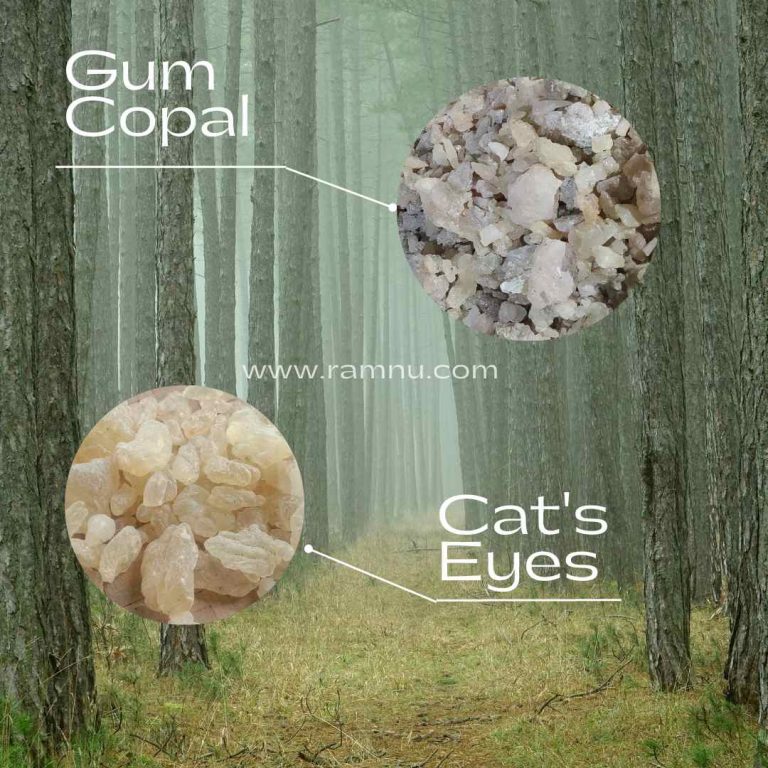Gum Copal and Cat’s Eye Resin Export Potential in the World Market
Gum Copal
Gum copal is a processed resin product obtained from Agathis dammara resin stems and tree trunks belonging to the Burseraceae family (Bursera, Protium). Gum copal is a basic ingredient in paper coating liquid to prevent ink from spreading. This material is also used as a mixture of shellac and varnish. Agathis Dammara produces copal which is known as “Manila Copal”. A. australis produces “Copal Kauri”.
Gum copal has long been known in Central American cultures such as the Aztecs and Mayans. The origin of the name “Copal” comes from the local language and means “incense” or “big”. Gum copal contains damar acid, resin and essential oils. It is used as an adhesive in dental fillings and plasters, when mixing glazes and varnishes. Gum copal oil is obtained by distillation and is used as an ingredient in perfumes. Copal is often considered or used as a substitute for resin and is used to make tires.
Cat's eye resin penetrates the export market
Krui is a protected area in Lampung Province, and as a protected area, Krui is rich in abundant natural resources. An ideal tourism opportunity for cat’s eye resin production areas (Shorea javanica). Most of the west coast area is a forest area, so there is no doubt that this area is designated as a nature reserve. Cat’s eye resin (Shorea javanica), produced on the west coast, is renowned for its quality and is a staple food in this region. The resin production areas are located in the northern coastal area, Karya Pengwa, Ngambur, Bengkunat and the south coast. Export destination countries for cat’s eye resin include India, Germany, the Philippines, France, Belgium, the United Arab Emirates, Bangladesh, Pakistan and Italy.
For the Pesisir Barat community, Krui collects resin not only for men but also for women. Cat’s eye resin (Shorea javanica) has been cultivated in Krui for centuries. The natural range of resin trees has long been known abroad. During the colonial period, the Dutch authorities used it as a raw material for various products such as varnish, paint, ink, incense and cosmetics. The cat’s eye resin (Shorea javanica) is graded according to various local qualities of the area such as A, B, C, D, E and powder/ash and of course these qualities differentiate each price. To sell resin products, it is not difficult for farmers to sell their resin products because they have many tanks.
The benefits of gum copal for industry
The resin tree has many benefits, starting from the parts of the tree to the sap from the resin tree itself. Here are the advantages of the resin tree:
1. Copal making
Copal is an important material in the paper industry. Copal is a product made from the sap of the resin tree, which is used to coat paper so that ink that has stuck to the paper does not spread on the paper.
2. Perfume or perfume mixture
Perfume usually consists of a mixture of various ingredients that produce a certain aroma. One of the ingredients that is mixed and processed to create certain fragrances is resin tree extract.
3. As Glue
Copal resin is widely used to make varnish or glue. Derived from resin, this glue is usually used on boats that are still made of wood and can also be used on various types of furniture that are also made of wood.
4. As varnish
Objects covered with varnish will appear shinier when using resin wood stain. Usually resin wood is processed into a varnish that can coat furniture and can also be used as a varnish for paintings on canvas.
5. Mixture of Batik Fabric Dye
Batik is one of Indonesia’s most famous traditional arts. Batik is made by hand painting method using a mixture of wax and resin resin.
6. As a support for the roof of the house
In some areas, resin wood is also commonly used as a single frame or house which is no less popular with light steel frames. Although damar wood is not as strong as teak or sandalwood, it has attracted the interest of building contractors and the use of resin wood as part of the roof frame of houses.
7. Incense Making
The wood harvested from the resin tree can also be used to make incense. Incense is usually used for religious rituals and certain traditional rituals. Incense is shaped like a seed that produces a very distinctive smell and usually emits smoke when burned.
The prices of gum copal vs the prices of cat's eye resin
Gum copal is the result of tapping a kind of resin from Agathis Dammara. This resin is yellowish in color and not too hard. Communities generally use gum copal to make a mixture of paper, lacquer and varnish. Cat’s eye resin is one of the most well-known varieties of resin. This is because cat’s eye resin has many benefits and has spread throughout the world. Many Indonesian resin traders export resin abroad. The price of cat’s eye resin is Rp. 29,000 per kilogram and can change at any time. Usually cat’s eye resin is used to mix shellacs, varnishes, paints and inks.
The latest prices of gum copal vary greatly depending on the type and quality of the resin. One of the best quality resins comes from Medan. Damar prices in Medan are quite expensive because there are many high-quality resins that come from Medan.

Latest 2022 Resin Sap Price List
Type of Resin & Weight of Resin | Price of resin in 2022 |
Cat’s eye resin 1 Kg | IDR 29.000 – 45.000 |
Gum copal 1 kg | IDR 18.000 – 35.000 |
